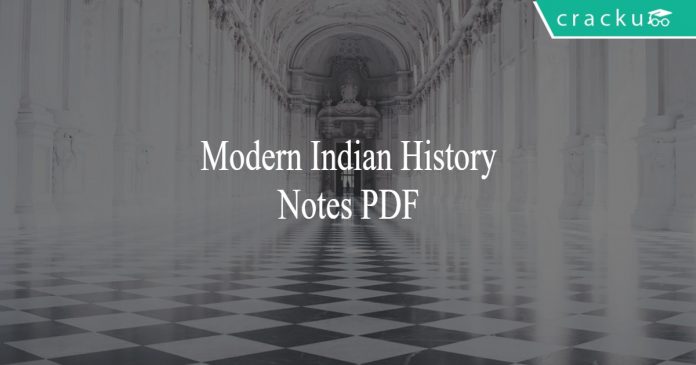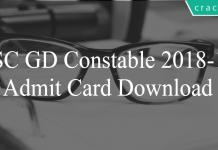Modern Indian History PDF Notes for Competitive exams:
This is an Modern Indian History notes for UPSC, SSC CGL, SSC CHSL, Railways RRB ALP, RRB Group-D exams.
Download Modern Indian history Notes PDF
20 RRB NTPC Mocks for Rs. 149 – Enroll here
Modern History Notes-2 (Download PDF)
Download Ancient Indian History Notes PDF
Download Medieval Indian History PDF
INDIA – 1700 AD to 1800 AD:
- Decline of the Mughal Empire is considered to have started in the initial years after 1700 AD,when Aurangzeb died in 1707 and there was an Internal war for succession among the three sons of Aurangazeb
- Muazzam
- Azam
- Kam Baksh
Notably, Aurangzeb was considered as the longest ruling Mughal Emperor
- However, Muazzam succeeded to the throne after the death of Aurangzeb and was titled Bahadur Shah – I
- He was also popularly known as Shah Alam – I
- During the reign of Bahadur Shah, Sikhs revolted against the Mughal Empire under the leadership of Banda Singh Bahadur
Jahandar Shah
- Jahandar Shah acended to the throne in 1712 with the help of Zulfikar Khan, who was virtually the head of Administration
- Title of “Mirza Raja” was given to Jai Singh of Malwa
- Title of “Maharaja” to Ajit Singh of Marwar
- Defeated by Farrukh Siyar in 1713
Farrukh Siyar
- He was ascended to the throne with the help of “Sayyid Brothers”
- Abdullah Khan
- Hussain Ali
- Sayyid Brothers are popularly known as “King Makers” in the Indian History
- Mir Qamar-ud-din Khan Siddiqi Bayafandi who is also known as the Nizam Ul Mulk and a descendent of Asaf Jahi Dynasty was assigned the duty of Governor of Deccan.
- Nizam Ul Mulk laid the foundation of Independent State of Hyderabad
- Farrukh Siyar was killed by Sayyid Brothers in 1719 and Muhammad Shah ‘Rangeela’ was ascended to the throne as the next emperor.
Muhammad Shah ‘Rangeela’
- The Independent State of Hyderabad was founded in 1724 by Nizam Ul Mulk during the reign of Muhammad Shah
- Marathas led by Baji Rao I invaded Delhi Sultanate in 1737
Battle of Karnal - Nadir Shah with the help from Sadat Khan defeated Mughals in the Battle of Karnal and achieved a decisive Victory in 1738
Nadir Shah Invasion
- Nadir Shah Summarily defeated the Mughals in the battle of Karnal and Mohammad Shah was taken Prisioner
- Nadir Shah took away the Peacock Throne and Koh-i-noor
Ahmed Shah Abdali
- Repeated invaded India five times between 1748 and 1761
- He was one of the generals of Nadir Shah
- The third battle of Panipat is fought between Marathas and Ahmed Shah Abdali (Durani Empire) who was supported by Rohilla Afghans of the Daob and Shuja-ud-daula, the Nawab of Awadh
- Notable Emperor of the Mughal empire before it was reduced to mere Military Power after 1759 was Shah Alam II
- Battle of Buxar
- Battle of Buxar was fought between British East India Company led by Hector Munro and Shah Alam II along with Mir Qasim – Nawab of Bengal and Shuja-ud-daula of Awadh in 1764. It was a decisive victory of British East India Company
- Treaty of Allahabad was signed in 1765 between British East India Company led by Robert Lord Clive and Mughal Emperor Shah Alam II
- Treaty of Allahabad is considered to be the Beginning of British Rule in India and bestowed the Powers of Collecting Tax in India and the Mughal Empire was reduced to mere Military Power.
The First Anglo – Maratha War
- The first Anglo Maratha War was fought between British East India Company Maratha Empire
- The Battle began with the Treaty of Surat and ended with the treaty of Salbai
- The company retained control of salsette and Broach and ordered Marathas to defeat Hyder Ali of Mysore and retake territories in the Carnatic
- Second Anglo – Maratha war was fought in 1803 between British East India Company and
- British Occupied Delhi in 1803 after the victory in Battle of Delhi against Marathas
- Mysore was ruled by Hyder Ali from 1761 to 1782
- Hyder Ali was succeeded by Tipu Sultan in 1782
- The Great Bengal Famine of 1770 was a famine between 1769 to 1773 that affected the lower Gangetic Plain of India from Bihar to Bengal
- Warren Hastings was appointed as the first governor General of Bengal in 1772
- The East India Company Act 1784 or The Pitt’s India Act was an act of the Parliament of Great Britain to address the shortcomings of the Regulation Act of 1773 by bringing the British East India Company’s rule in India under the control of the British Government. The act was named after the then British Prime Minister William Pitt the Younger.
- Foundation of Asiatic Society of Bengal with the Help of William Jones in 1784
- Tipu Sultan was killed by the British East India Company, who got the support of the Nizam of Hyderabad, in 1799 while defending his fort at Srirangapatna
- The City of Jaipur was founded by Raja Jai Singh II
- Euclid‘s ―Elements of Geometry was translated into Sanskrit by Raja Jai Singh II
- Important Marathas Families
- Pune – Peshwa
- Baroda – Gaekwad
- Nagpur – Bhosle
- Indore – Holkar
- Gwalior – Scindia
Railways Group D Previous Year Papers
INDIA – 1800 AD to 1947 AD
- Lord Wellesley became the Governor General of India in 1798
- Lord Wellesley signed the First Subsidiary Treaty with the Nizam of Hyderabad in 1798
- Lord Wellesley often described himself as the “Bengal Tiger”
- British Occupied Delhi in 1803 in the Battle of New Delhi
- Vellore Mutiny of 1806 was the first instance of Violent Mutiny by the Indian Sepoys against the East India Company which lasted only for a day but was brutal.
- Lord Minto I was appointed Governor General of India in 1807
- Treat of Amritsar was signed between Bitish East India Company and Ranjit Singh – Founder of Sikh Empire
- Lord Hastings was appointed Governor General of India in 1812
- Ryotwari System was introduced in Madras by Thomas Munro in .
- Anglo – Nepal War or Gorkha War was fought in 1814-1816 between British East India Company and Kingdom of Gorkha,in which Kingdom of Gorkha lost the battle and British ceded one-third of the Nepal Kingdom at the Treaty of Sagauli
- Lord William Bentick became the first Governor General of India by The Government of India Act 1833 or Charter Act 1833
- Lord William Bentick was also considered the Father of Modern Western Education in India
- Foundation of Calcutta Medical College in 1835
- Officiating Governor General Charles Metcalfe was popularly called as the Liberator of the Press for his work on abolition of Press restrictions
- Lord Auckland appointed as Governor General of India in 1836
- The Agra Famine of 1837-38 affected nearly 8 Million people of North India
- The First Anglo – Afghan war was fought between Imperial British India and the emirate of Afghanistan from 1839 – 1842
- Ghazni and Kabul were captured by General Keane during the Afghan War
- The first Anglo – Sikh war was fought between Sikh empire and the British East India Company at the Battles of Mudki and Ferozpur
- Lord Dalhousie became the Governer General of India in 1848
- The policy of Doctrine of Lapse was introduced by Lord Dalhousie, the policy means that if the ruler of a princely state or territory under the paramountcy of the Company died without a natural heir, the state/territory would automatically be annexed to the British empire.
- The first Indian Railway Line was laid in 1853 from Bombay to thane and Second from Calcutta to Ranigunj
- Post Office Act was passed in 1854 and Postal stamp was issued for the first time
- The Governor General of India in 1855 is Lord Canning
- Hindu Marriage Act was passed in 1856
- The revolt of 1857 or Sepoy Mutiny or considered the first war of Independence took place in 1857
- Important Persons of the revolt of 1857 are:
- Bahadur Shah Zafar – the last Mughal emperor of India
- Jhansi Lakshmi Bai – Died in 1958 fighting against the British
- Nana Saheb – escaped to Nepal
- Kunwar Singh
- Nawab Wajib Ali Shah
- Foundation of Calcutta, Bombay and Madras Universities took place in 1857
- Indian Council Act was passed in 1858
- Indigo Revolt – 1859 -60 is a peasant movement based in Bengal
- Indian Penal Code – Bare Act was passed in 1860
- Indian High Court Act passed in 1861
Get RRB Unlimited at Rs. 249 – Use coupon RRBDREAM70
- The Bihar Famine and the Bengal Famine observed between 1873-1874
- The Bhutan war was fought between British India and Bhutan in 1864-65
- At the Durbar of Delhi in 1877, Queen Victoria Proclaimed empress of India
- Vernacular Press Act was passed in the Year 1878
- The second Anglo- Afghan war was fought between British Raj and Sher Ali Khan Emirate of Afghanistan from 1878-1880
- British won the war and many important milestones were met by the British India
- “Durand Line” was formed as the border between Afghanistan and British India at the Treaty of Gandamak.
- Indian National Congress was found by AO Hume in 1885
- First session of INC was held in Bombay presided by WC Banerjee in 1885
- Indian Council Act was passed in 1892
- Ganesh Chaturhti was revived by Lokamanya Bal Gangadhar Tilak in 1893
- Partition of Bengal into East Bengal and Rest of the Bengal as Assam took place in 1905 by proclamation of Lord Curzon – Viceroy of India
- National Council of Education was found in 1906 by Indian nationalists to promote Science and Technology as a part of Swadeshi Industrialization Movement
- Indian National Congress took the call of Swadeshi at the Benaras Session in 1905 presided by GK Gokhale
- Indian Muslim League was formed at Dhaka by Muhammad Ali Jinnah, Aga Khan III and Khwaja Salimullah in 1906
- Bengal National College was founded in 1906 with Aurobindo Ghosh as the First Principal
- The Indian National Congress split into two Groups – Extremists and Moderates at the Surat Session in 1907
- Extremists were led by Lala Lajpat Rai, Bal Gangadhar Tilak and Bipin Chandra Pal
- Moderates were led by G K Gokhale
- Indian Council Act 1909 or popularly called as Morley Minto Reforms was passed in 1909. The reforms are also called Divide and Rule Policy
- Separate Electorate for Muslims was created and Muslims could only vote to their Muslim Candidates.
- Delhi Durbar was held in 1911 to commemorate the coronation of King George V and Queen Mary as Emperor and Empress of India
- The Partition of Bengal is revoked in the Delhi Durbar
- Capital of India was transferred from Calcutta to Delhi
- Delhi Conspiracy Case 1912, assumed to be hatched by Ras Bihari Bose, a bomb was thrown at Viceroy Lord Hardinge in Chandni Chowk, Delhi
- Gandhiji returned to India from South Africa in 1915
- Sabarmathi Ashram was founded by Gandhiji at Ahmedabad in the same year
- Home Rule League was founded by Bal Gangadhar Tilak in 1916
- Annie Besant who also started the Home Rule Movement in September 1916 started two newspapers Young India and Commonwealth
- Banaras Hindu University was founded by Pandit Madan Mohan Malviya in 1916
- Historic Lucknow pact was signed in 1916 where a unity was formed between Congress and Muslim League
- Shreemati Nathibai Damodar Thackersey Women’s University was founded in 1916 in Poona
- Chaparan Satyagraha in 1917 and Kheda Satyagraha in 1918 was started by Gandhiji which later became landmark movements in the Indian Freedom Struggle
- Jalianwala Bagh Massacre took place on 13th April 1919
- Rowlatt Act passed in 1919 gave ultimate powers to British to arrest and imprison suspects without trail for a period of Two Years
- Two brothers Mohammad Ali and Shaukat Ali started the Khilafat Movement in 1919
- Government of India Act 1919 also called as Montague – Chelmsford reforms was passed
- Gandhiji was elected as the President of All India Khilafat Committee in Delhi
- Non- Cooperation movement was launched by Congress in 1920
- The Chamber of Princes was an established in 1920 by a royal proclamation of King-Emperor George V to provide a forum in which the rulers of the princely states of India could voice their needs and aspirations to the colonial government of British India.
- Swaraj Party was founded by C R Das and Motilal Nehru in 1922
- Vishva Bharti University was started by Rabindranath Tagore in 1922
- Communist Party was founded by MN Roy in 1925
- Simon Commission was appointed by John Simon in 1927 to review the political situation in India & to introduce further reforms & extension of parliamentary democracy which was opposed by Indian Leaders and Lala Lajpat Rai was severly beaten at Lahore while raising the slogan of Simon Go Back. He died later in 1928
- Jinnah rejected the “Nehru Report” and dreq a 14 Point demands called “The 14 Points of Jinnah”
- In Lahore Session of 1929 Jawaharlal Nehru called out for Poorna Swaraj or Complete Independence to be the goal of the National Movement
- A Tri colour flag was hoisted on December 31 1929 by INC
- Congress Observed 14 February 1930 as the Indian Independence day and passed the Civil Disobedience resolution
- Gandhi submitted a 11-point demand to Lord Irwin which was subsequently rejected and the Civil Disobedience Movement was started by Gandhiji with the Dandi March for Salt Satyagraha on April 06th 1930
- First Round Table Conference in London on November 12 1930 to discuss Simon Commission
- Gandhi Irwin Pact Signed in 1931 to call off Civil Disobedience Movement and join the Second Round Table Conference
- Second Round Table conference was unsuccessful, Gandhiji represented as the sole representative of Congress
- Bhagat Singh, Sukhdev and Rajguru executed in 1931
- Announcement of “Communal Award” by British Prime Minister Ramsay Mc Donald instilled rage among the Indian Leaders
- An agreement between BR Ambedkar and Mahatma Gandhi was signed in 1932 called as Poona Pact to Break Gandhiji’s fast unto Death
- Third Round Table Conference in 1933 went useless without any participation of the Congress
- Foundation of Congress Socialist Party was instituted by Acharya Narendra Dev and Jai Prakash Narain at first meeting in Patna in 1934
- Government of India Act 1935 was passed formed on the basis of report submitted by Simon in 1930 and decisions taken in the Third Round Table Conference.
- The first All India Peasant Organisation called as the All India Kisan Sabba was formed with Sahjananda as the President in 1936
- Another major Milestone took place in the Indian History with the Passing of Resolution of Pakistan by the Muslim League at the Lahore Session in 1940
- The offer of the Viceroy Linlithgow created an outrage in the Nationalists and Congress Party and was rejected in 1940 which futher led to the call of Individual Satyagraha ( Vinobha Bhave was the first Individual Satyagrahi and Jawaharlal Nehru was Second)– the offer is popularly called as “August Offer”
- Maulana Azad has rejected the Cripps Mission in 1942 which promised a Dominion status to India after the World War II
- Quit India Movement began in 1942
- Indian National Army (Azad Hind Fauj) was formed by Netaji Subash Chandra Bose in 1942
- In 1943 Gandhiji began a historical 21 Day Fast
- On 21st October 1943 Subash Chandra Bose set up the Provisional Government of Free India in Singapore
- Muslim League adopted the Slogan of Divide and Quit in Karachi Session of 1943
- C Rajagopalachari has set an action plan for Freedom, which was not endorsed by Jinnah in 1944
- Multiple Trails of INA Prisoners took place at Red Fort in 1945
- Viceroy Lord Wavell called 22 Prominent Indian Leaders to Shimla Conference to discuss the Wavell Plan which went vain.
IBPS PO Previous papers (Download pdf)
IBPS Clerk Previous papers (download pdf)
- British Prime Minister Lord Attlee announced a landmark Cabinet Mission Plan wherein a cabinet from Britain will visit India to discuss various proposals that were later accepted by Congress and Muslim League
- However, Muslim League withdrew later from Cabinet Mission demanding for separate Pakistan
- The Constituent Assembly was formed in December 1946 and Dr Rajendra Prasad was elected the President and the first session was boycotted by the Muslim League
- Britain Prime Minister made a landmark Announcement that British would withdraw from India before June 1948
- Lord Mountbatten was appointed as the Vice-Roy on 24th March 1947
- Mountbatten Plan was outlined for the partition of India on June 3rd 1947 and was accepted by both Congress and Muslim League
- Indian Independence Bill was formulated on 4th July 1947 and the bill was passed on 15th July 1947
- India was declared Freedom on 15th August 1947
- At the time of Independence, there were 562 Princely states majority of these states have signed the instrument of Accession, which was introduced by Government of India Act 1935, to join the dominion of India,expect for few Princely states which was possible because of the efforts of Sardar Vallabhbhai Patel, the First Home Minister of Independent India and referred to as the Iron Man of India.






[…] Modern Indian History notes – 2th March 2018 […]
[…] Modern Indian History PDF Notes […]
[…] Modern Indian History notes […]
how can i download